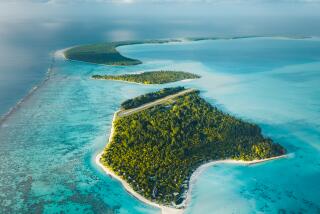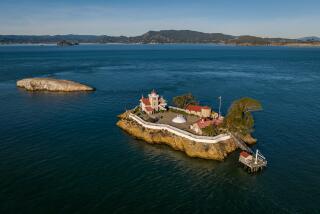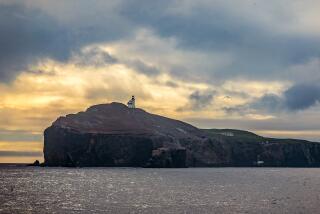A winter day on the island of Jersey in the English Channel
- Share via
reporting from st. helier, jersey — Gusts of wind lashed at the bay windows of the ferry terminal in St-Malo, France. The ground wobbled under my feet. A child whirled at dizzying speed around his parents and a few hapless passengers, contributing to my queasiness.
I was headed to the island of Jersey, in the English Channel, for a taste of winter that Southern California does not deliver. This was a treacherous journey over tempestuous seas and across the international boundary that separates France and the largest of the Channel Islands.
The weather was truly not that dreadful, although winter travel to the Channel Islands is never a tropical cruise. That my original ferry reservation out of Granville, France, was canceled because of stormy weather did not make my weak sea legs feel any sturdier. A last-minute switch meant I could depart from St-Malo, a fortunate substitution that allowed me to visit the cobbled streets and fortifications of the walled port city and the island sanctuary of nearby Mont-St-Michel.
High on St-Malo’s ramparts, I spied the reassuring hulk of the catamaran that was to deliver me to St. Helier, the capital city on Jersey’s southern shore, in a little more than an hour. A ferry terminal official blamed the delay in boarding on unpredictable tides, and I saw the window of opportunity to catch Jersey’s annual Fête dé Noué parade shrink.
The time-zone loss of one hour nearly cancelled out the crossing time, which I spent studying the passengers as they browsed the duty-free deals offered on-board to those heading for the Channel Islands (of which Jersey, Guernsey and Alderney are the largest in the archipelago), a British crown dependency that is not part of the European union.
I dropped my bag at the Revere Hotel in St. Helier and hurried to catch the last minutes of the Fête dé Noué’s Christmas-time procession of floats covered with twinkling lights.
“Do you speak English?” asked an elderly gentleman in a tweed jacket and cap when he saw me struggle with the St. Helier map. His offer of help came at the right time, because I had forgotten to note which street my hotel was on, let alone how to get back to it.
England it is not, but St. Helier does feel very British. English is spoken here, of course. If France can point to historical and geographical ties, they appear mostly in the islands’ political structure and some dual-language street names that do not suffer proper translation. Christmas party revelers packed the cozy pubs and restaurants in the city center, which made it a challenge to find a table. In search of Yorkshire pudding, I ended the evening at the Harbour Room Restaurant, puffy bread chasing roast beef.
Displays at the Jersey Museum told the tale of the island’s Viking roots and the conflicts between England and France, starting with its annexation by the Duchy of Normandy in 933. Exhibits on agriculture (the famed Jersey cow), tourism and finance explained how each contributes to the island’s identity. This last sector accounts for 58% of its gross domestic product, a reflection, perhaps, of the sympathetic tax structure that attracts scores of international investment banks to this island of fewer than 100,000 souls.
With a few Jersey bank notes in my pocket, I headed out of town for a daylong driving tour of the kidney-shaped island. Until I got the left-side-of-the-road driving under control, it took a fair amount of time to cover the six miles from St. Helier to Mont Orgueil Castle in Gorey on the east coast. Built on a hilltop in the early 13th century, the imposing castle was an outpost of England’s defenses for hundreds of years. Recycled as a prison, Mont Orgueil also was a garrison when the island was occupied by German forces in World War II.
The road to the Durrell Wildlife Conservation Trust and its wildlife park appeared perfectly reasonable on the map, but it narrowed in places to a single lane. Signage — in the form of elegant instructions on tiny markers — was challenging to read, even though I kept the Ford Fiesta nowhere near the island’s limit of 40 mph. A crash into a roadside ditch seemed imminent, but I arrived at the zoological park, near the tiny settlement of Trinity, unscathed.
Before I ventured into the chilly wind for a close encounter with exotic animals, I continued my exploration of British cuisine with a plate of bangers, mash and roasted vegetables in the Dodo Restaurant at the Durrell.
The eatery’s name is appropriate for the facility, which works to save species from extinction. Chief among the 1,400 critters under its care are Sumatran orangutans, Western lowland gorillas, Madagascan lemurs, Brazilian black lion tamarins and silvery marmosets. Its reach extends to conservation programs around the world.
On the wild and craggy north coast, I squeezed onto the not-so-grand Grande Rue between the villages of St. John and St. Mary. At the road’s end, a level path led me through a small forest and across headlands where fierce winds threatened to hurl me into the sea. Anxious to beat the waning daylight, I missed Devil’s Hole, a dramatic crater formed when wave erosion forced the collapsed of a cave’s roof.
The pale sun was sinking into the churning waters of St. Ouen’s Bay as I reached the west-facing surfers’ haven. By the time I steered past picturesque St. Brelade and St. Aubin for the straight shot back to St. Helier, the day behind the wheel had turned me into a local.
More to Read
Sign up for The Wild
We’ll help you find the best places to hike, bike and run, as well as the perfect silent spots for meditation and yoga.
You may occasionally receive promotional content from the Los Angeles Times.






